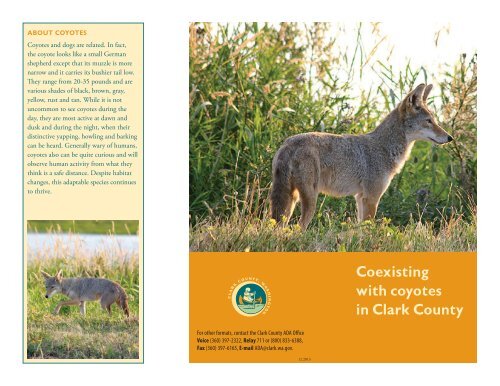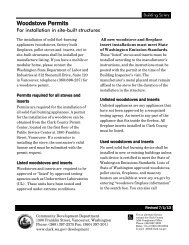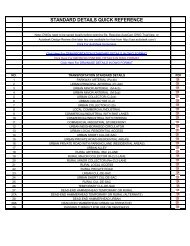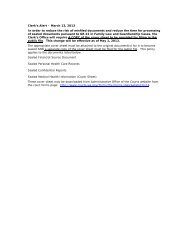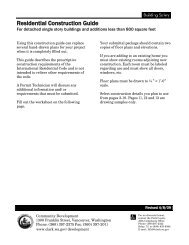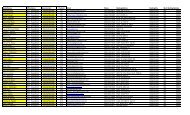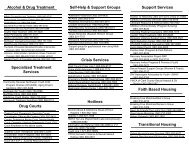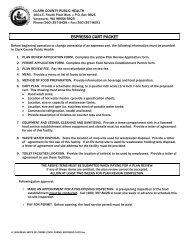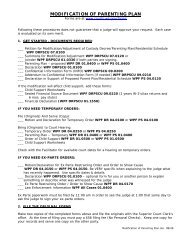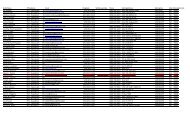At least 50,000 coyotes are estimated lto live in the ... - Clark County
At least 50,000 coyotes are estimated lto live in the ... - Clark County
At least 50,000 coyotes are estimated lto live in the ... - Clark County
- No tags were found...
Create successful ePaper yourself
Turn your PDF publications into a flip-book with our unique Google optimized e-Paper software.
ABOUT COYOTESCoyotes and dogs <strong>are</strong> related. In fact,<strong>the</strong> coyote looks like a small Germanshepherd except that its muzzle is morenarrow and it carries its bushier tail low.They range from 20-35 pounds and <strong>are</strong>various shades of black, brown, gray,yellow, rust and tan. While it is notuncommon to see <strong>coyotes</strong> dur<strong>in</strong>g <strong>the</strong>day, <strong>the</strong>y <strong>are</strong> most active at dawn anddusk and dur<strong>in</strong>g <strong>the</strong> night, when <strong>the</strong>irdist<strong>in</strong>ctive yapp<strong>in</strong>g, howl<strong>in</strong>g and bark<strong>in</strong>gcan be heard. Generally wary of humans,<strong>coyotes</strong> also can be quite curious and willobserve human activity from what <strong>the</strong>yth<strong>in</strong>k is a safe distance. Despite habitatchanges, this adaptable species cont<strong>in</strong>uesto thrive.Coexist<strong>in</strong>gwith <strong>coyotes</strong><strong>in</strong> <strong>Clark</strong> <strong>County</strong>For o<strong>the</strong>r formats, contact <strong>the</strong> <strong>Clark</strong> <strong>County</strong> ADA OfficeVoice (360) 397-2322, Relay 711 or (800) 833-6388,Fax (360) 397-6165, E-mail ADA@clark.wa.gov.12.2013
An <strong>estimated</strong> <strong>50</strong>,<strong>000</strong> <strong>coyotes</strong> <strong>live</strong> <strong>in</strong><strong>the</strong> state of Wash<strong>in</strong>gton, and <strong>coyotes</strong>have been sighted <strong>in</strong> <strong>Clark</strong> <strong>County</strong>. Nolonger just a rural problem, a few <strong>coyotes</strong>have been seen lop<strong>in</strong>g through more urbanneighborhoods.No coyote attacks on people were documented<strong>in</strong> Wash<strong>in</strong>gton until 2006. That year<strong>in</strong> K<strong>in</strong>g <strong>County</strong>, <strong>coyotes</strong> bit three people,snapped at two o<strong>the</strong>rs and charged oneperson. The <strong>coyotes</strong>’ unusually aggressivebehavior likely was from be<strong>in</strong>g fed by people.Opportunists as hunters or scavengers, <strong>coyotes</strong>have killed or <strong>in</strong>jured several pets.People can safely coexist with <strong>coyotes</strong>and discourage <strong>in</strong>teractions with <strong>the</strong>m byfollow<strong>in</strong>g a few simple guidel<strong>in</strong>es recommendedby <strong>Clark</strong> <strong>County</strong> Animal Protectionand Control. The guidel<strong>in</strong>es <strong>are</strong> especiallyimportant for people who <strong>live</strong> along or nearnatural habitat <strong>are</strong>as or green belts.Never give <strong>coyotes</strong> a source of food.Research <strong>in</strong> national parks suggests coyoteattacks <strong>are</strong> related to loss of <strong>the</strong>ir natural fearof humans once <strong>the</strong>y associate people withfood. With <strong>the</strong> expansion of urban <strong>are</strong>asand o<strong>the</strong>r habitat changes, <strong>the</strong>se <strong>in</strong>telligentanimals have learned that pet food, garbageand garden crops can provide <strong>the</strong> basics forsurvival. Never feed any wild animal, ei<strong>the</strong>rdirectly or <strong>in</strong>directly. Don’t attract <strong>coyotes</strong> byputt<strong>in</strong>g out food or leav<strong>in</strong>g pet food or wateroutside.Make sure outdoor trash b<strong>in</strong>s <strong>are</strong> securedso <strong>coyotes</strong> or dogs can’t get <strong>in</strong>to <strong>the</strong>m.Use tight-lock<strong>in</strong>g trash cans or wrap bungeecords around <strong>the</strong>m so <strong>the</strong>y <strong>are</strong> not easilyopened if knocked over. If you compost, besure to use enclosed b<strong>in</strong>s and never <strong>in</strong>cludeanimal matter such as meat, bones, fat or fishscraps. These can draw <strong>coyotes</strong> more quicklythan decompos<strong>in</strong>g vegetable matter.Keep children’s play <strong>are</strong>as <strong>in</strong> your yardfree of groundcover, fruit or birdseedthat could attract small birds or mammals,which <strong>are</strong> a primary food source for <strong>coyotes</strong>.Keep fruit trees fenced or pick up fallenfruit. Fruit will attract birds, and <strong>coyotes</strong>will try to catch and eat <strong>the</strong> birds. Also,keep birdfeeders elevated or hang<strong>in</strong>g aboveground. Clean up spilled seed.If your yard is next to a green space,consider fenc<strong>in</strong>g your property to prevententry by wild animals. Make sure <strong>the</strong>fenc<strong>in</strong>g is securely anchored and does notconta<strong>in</strong> gaps <strong>coyotes</strong> could squeeze through.Fences should be at <strong>least</strong> six feet tall andextend at <strong>least</strong> eight <strong>in</strong>ches <strong>in</strong>to <strong>the</strong> ground.Consider <strong>in</strong>stall<strong>in</strong>g a motion-sensitive light<strong>in</strong>gsystem.Keep pets <strong>in</strong>side or conf<strong>in</strong>ed securely <strong>in</strong> akennel or covered exercise yard, especially atnight. Allow <strong>the</strong>m only controlled access to<strong>the</strong> outdoors, such as <strong>in</strong> a fenced yard or ona leash. Conf<strong>in</strong>e poultry <strong>in</strong> sturdy cages orpens at night.Do not leave small children unattended<strong>in</strong> your yard or unsupervised <strong>in</strong> woodland<strong>are</strong>as where <strong>coyotes</strong> have been spotted.Never approach or run from a coyote.Instead, make yourself look big and shout.Teach children to respect all wildlife from adistance.If a coyote visits your yard, make loudnoises, wave your arms, throw rocks orsticks at it, or spray it with a garden hose.Portable air horns, motor vehicle horns, propanecannons, starter pistols or low-poweredpellet guns can be effective. Help <strong>coyotes</strong>reta<strong>in</strong> <strong>the</strong>ir natural war<strong>in</strong>ess of humans.WHO TO CALL FOR HELPIf <strong>the</strong>se tactics fail and you need help witha serious coyote problem, please contact<strong>Clark</strong> <strong>County</strong> Animal Protection andControl at (360) 397-2488 or animal@clark.wa.gov.For more <strong>in</strong>formation about <strong>coyotes</strong>,read <strong>the</strong> state’s Liv<strong>in</strong>g with Wildlifeseries at http://wdfw.wa.gov/wlm/liv<strong>in</strong>g/<strong>coyotes</strong>.htm.


